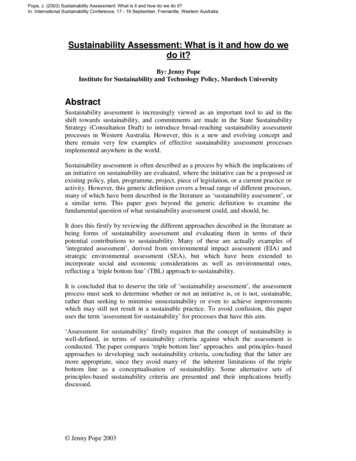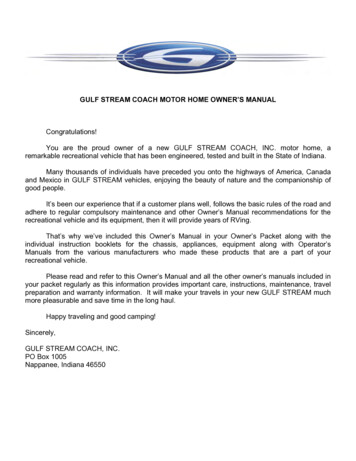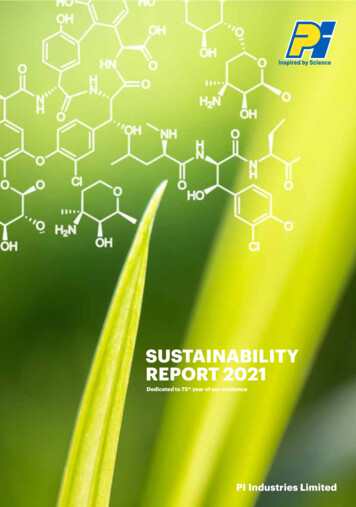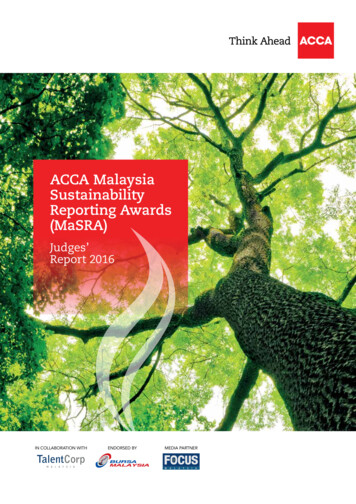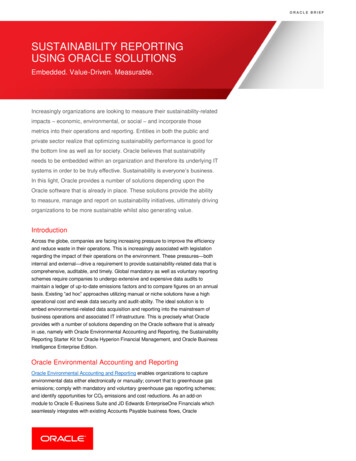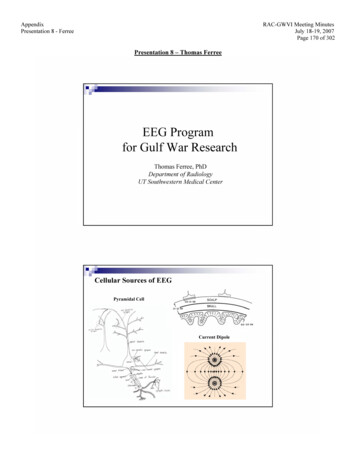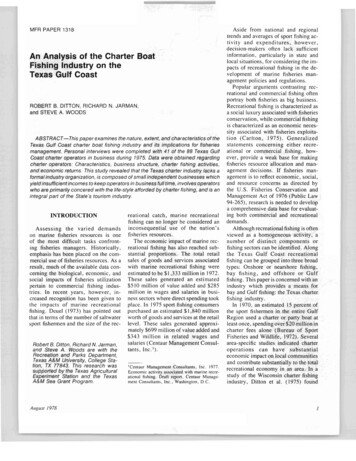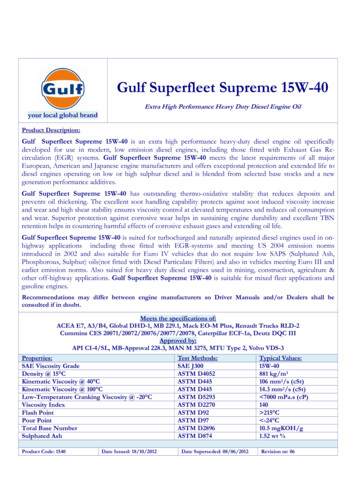
Transcription
TTI: 0-6962Enhancing the Sustainability of Gulf IntracoastalWaterway Dredge Material Placement AreasTechnical Report 0-6962-R1Cooperative Research ProgramTEXAS A&M TRANSPORTATION INSTITUTECOLLEGE STATION, TEXASin cooperation with theFederal Highway Administration and theTexas Department of -R1.pdf
1. Report No.2. Government Accession No.Technical Report Documentation Page3. Recipient's Catalog No.FHWA/TX-19/0-6962-R15. Report Date4. Title and SubtitleENHANCING THE SUSTAINABILITY OF GULFINTRACOASTAL WATERWAY DREDGE MATERIALPLACEMENT AREAS7. Author(s)C. James Kruse, Ali Mostafavi, Chao Fan, Juan Moya, and Anthony Risko10. Performing Organization Name and AddressPublished: April 20196. Performing Organization Code8. Performing Organization Report No.Report 0-6962-R110. Work Unit No. (TRAIS)Texas A&M Transportation InstituteThe Texas A&M University SystemCollege Station, Texas 77843-313511. Contract or Grant No.Project 0-696212. Sponsoring Agency Name and Address13. Type of Report and Period CoveredTexas Department of TransportationResearch and Technology Implementation Office125 E. 11th StreetAustin, Texas 78701-2483Technical Report:September 2017–October 201814. Sponsoring Agency Code15. Supplementary NotesProject performed in cooperation with the Texas Department of Transportation and the Federal HighwayAdministration.Project Title: Determine Placement Areas SustainabilityURL: http://tti.tamu.edu/documents/0-6962-R1.pdf16. AbstractPlacement areas for dredged material (DMPA) from the Gulf Intracoastal Waterway (GIWW) are aresponsibility of the state of Texas. Given population and industrial growth along the coastline and thecontinual need for dredging, it is important to use the sites efficiently and ensure their integrity. This researchprovided the analytical framework and methodology that will enable the Texas Department of Transportationto develop a strategic program for the restoration and protection of the DMPAs of the GIWW along theTexas Coast. The work plan combined general physical, environmental, and economic data to providestrategic direction and develop information on techniques and potential measures to enhance the long-termperformance of placement areas and dredging activities. A tool using Analytic Hierarchy Process was createdto evaluate various feasible solutions based on consideration of multiple criteria such as lifecycle costs,safety, and environmental sustainability.The research focused on East Matagorda Bay, the highest priority segment of the GIWW. Protecting thisreach of the GIWW against long-fetch bay-induced wind/wave energies will significantly increase navigationsafety and efficiencies and reduce navigation channel shoaling, resulting in reduction of maintenancedredging cycles.The research produced an extended list of improvement features, considerations, and evaluation options thatcould be prioritized as shoreline changes are observed or storm-induced waves and shoaling or current/waveregimes negatively impact navigation safety.17. Key Words18. Distribution StatementGulf Intracoastal Waterway, GIWW, PlacementAreas, DredgingNo restrictions. This document is available to thepublic through NTIS:National Technical Information ServiceAlexandria, Virginiahttp://www.ntis.gov19. Security Classif. (of this report)20. Security Classif. (of this page)21. No. of PagesUnclassifiedUnclassified134Form DOT F 1700.7 (8-72) Reproduction of completed page authorized22. Price
ENHANCING THE SUSTAINABILITY OF GULF INTRACOASTALWATERWAY DREDGE MATERIAL PLACEMENT AREASbyC. James KruseDirector, Center for Ports & WaterwaysTexas A&M Transportation InstituteAli MostafaviAssistant ProfessorTexas A&M UniversityChao FanGraduate Research AssistantTexas A&M UniversityandJuan MoyaAnthony RiskoCoastal ProgramFreese and Nichols, Inc.Report 0-6962-R1Project 0-6962Project Title: Determine Placement Areas SustainabilityPerformed in cooperation with theTexas Department of Transportationand theFederal Highway AdministrationPublished: April 2019TEXAS A&M TRANSPORTATION INSTITUTECollege Station, Texas 77843-3135
DISCLAIMERThis research was performed in cooperation with the Texas Department of Transportation(TxDOT) and the Federal Highway Administration (FHWA). The contents of this report reflectthe views of the authors, who are responsible for the facts and the accuracy of the data presentedherein. The contents do not necessarily reflect the official view or policies of the FHWA orTxDOT. This report does not constitute a standard, specification, or regulation.The United States Government and the State of Texas do not endorse products or manufacturers.Trade or manufacturers’ names appear herein solely because they are considered essential to theobject of this report.v
ACKNOWLEDGMENTSThis project was conducted in cooperation with TxDOT and FHWA. The authors thank thefollowing members of the TxDOT Project Monitoring Committee for their guidance and support: Emily Shelton, Maritime Division.Matthew Mahoney, Maritime Division.Sunil Chorghe, Houston District.vi
TABLE OF CONTENTSPageList of Figures. xList of Tables . xiiExecutive Summary . 1Introduction and Background . 1Selection of Critical Area for Detailed Evaluation . 1East Matagorda Bay: Current Conditions, Dredging Activities, and Potential EconomicImpacts . 1Alternative Natural Solutions . 4Feasible Solutions for Selected Area . 6Proposed Shoreline Protection Solutions in East Matagorda Bay . 9Programmatic Approach to the Sustainability of the DMPAs . 11Application of Findings to Other Areas . 11Summary of Conclusions and Recommendations . 11Chapter 1: Selection of Critical Locations to be Evaluated . 13Introduction. 13Locations Evaluated . 14East Matagorda Bay . 14West Galveston Bay . 16East Galveston Bay . 17Cedar Lake . 17Matagorda Bay . 17San Antonio Bay . 17Chapter 2: Current Conditions, Dredging Activities, and Potential EconomicImpacts . 19Introduction. 19Physical Conditions . 19Dredging Data . 21Habitat Types . 22Effect of Reduced Draft . 24Assumptions and Base Data. 24Light Loading Analysis. 25Cost of Dredging . 26Differential between Annual Average Costs Avoided by Dredging and Cost ofDredging . 27Chapter 3: Alternative Natural Solutions. 29Introduction. 29Criteria for Living Shore Concepts . 30Classification of Living Shoreline Alternatives. 31Green Softer Techniques. 33Grey Harder Structures . 38Examples of Living Shoreline Projects in Texas Estuaries . 43Shamrock Island in Corpus Christi Bay. 43vii
Living Shoreline Projects along the GIWW . 45Lessons Learned . 54Chapter 4: Feasible Solutions for the Selected Area . 57Introduction. 57East Matagorda Bay Physical Conditions . 57Conditions of Evaluated DMPAs in East Matagorda Bay . 59DMPA 101 . 60DMPAs 102-A and 102-B . 60DMPA 102-C . 62DMPA 103 . 63DMPA 104 . 64DMPA 105 . 65Recommended DMPA Improvements to Enhance Navigation Safety and Efficiencies . 65Primary Priorities to Enhance Navigation Safety by Improving the DMPAs in EastMatagorda Bay . 65Secondary Priorities to Enhance Navigation Safety by Improving the DMPAs inEast Matagorda Bay . 66Existing Methods to Protect the DMPAs . 66Proposed GIWW-Facing Shoreline Protection: Example McFaddin . 68Design Recommendations by the USACE Galveston District . 72Recommendation for GIWW-Facing Shorelines . 72Recommendation for Bay-Facing Shorelines . 73Design Considerations for GIWW-Facing Shoreline Protection Solutions. 74Crest Elevation of Breakwater . 74Low-Crested Breakwater Analysis . 74Design Considerations for Bay-Facing Shoreline Protection Solutions . 76Rip Rap Stone Revetment/Breakwater . 76Concrete Articulated Mat Revetment . 79Reef Balls . 81Proposed Applications of Shoreline Protection Solutions in East Matagorda Bay . 82Priority Area. 82Proposed Improvement Features for the GIWW EMB Region and AssociatedDMPAs . 83Applications to Other Areas . 85Potential Sediment Sources . 85Programmatic Approach to the Sustainability of the DMPAs . 86Financial Resources . 86Sediment Resources . 88Policies . 88Financial Resources That Can Be Leveraged for Ecological Restoration andInfrastructure . 90Chapter 5: Application of Findings to Other Areas . 99Introduction. 99Analytic Hierarchy Process . 99Introduction to User Guide . 102Spreadsheet Tool. 103viii
Chapter 6: Conclusions and Recommendations . 105Geographical Distribution. 105Navigation Safety . 105GIWW-Facing Engineered Features . 105Bay-Facing Engineered Features . 106AHP Application. 106Appendix A: Areas in Vicinity of Cuts Mentioned by Barge Operator. 107Appendix B: User Guide to AHP Tool . 109References . 121ix
LIST OF FIGURESPageFigure 1. Location of DMPAs in EMB and Habitat Types Identified by National Oceanicand Atmospheric Administration (NOAA). . 3Figure 2. Land Gaps between EMB and the GIWW. . 15Figure 3. Potential and Current BUDM in West Galveston Bay. . 16Figure 4. Location of DMPAs in EMB and Habitat Types Identified by NOAA. . 20Figure 5. Bathymetric Chart of EMB. . 23Figure 6. Definition and Classification of LS Techniques. . 30Figure 7. Aerial Image of Location of Shamrock Island. . 43Figure 8. Shamrock Island in 2004 after Installation of Geotextile Tubes on NortheasternPortion. . 44Figure 9. Close-Up of Geotextile Tubes in 2004 Failing. 44Figure 10. Shamrock Island in 2016 Showing New Set of Shoreline Protection Devices,including Submerged and above Water Rock Breakwaters. . 45Figure 11. West Galveston Bay Mooring Buoy Area Shoreline Protection and HabitatRestoration Project. . 46Figure 12. West Galveston Bay Mooring Buoy Area Shoreline Protection and HabitatRestoration Solution after Construction in January 2004. . 46Figure 13. Close-Up of Geotextile Tubes after a Few Years of Performance in January2004. 47Figure 14. Close-Up of Geotextile Tubes after 10 Years of Performance in January 2010. . 47Figure 15. Close-Up of the Geotextile Tubes after 15 Years of Performance in January2017. 48Figure 16. Typical Cross Section for a Rip Rap Revetment Used by USACE. . 49Figure 17. Typical Cross Section for an Oyster Castle Breakwater Used by USACE. . 49Figure 18. Typical Cross Section for a Sacrificial Berm Used by USACE. . 49Figure 19. McFaddin National Wildlife Refuge Shoreline Protection Solution on GIWW. . 50Figure 20. Erosional Forces from Barge Wakes along the Shorelines of GIWW atMcFaddin National Wildlife Refuge. . 51Figure 21. Development of Marsh behind Revetment along Shorelines of GIWW atMcFaddin National Wildlife Refuge. . 51Figure 22. Shorelines of GIWW at McFaddin National Wildlife Refuge at NavigationMark 88 000, August 2018. . 52Figure 23. Mad Island Shoreline Protection Project on GIWW (Stations 823 000 to833 000), November 2014. . 53Figure 24. Retreating Shorelines and Eroding Marshes along GIWW (Stations 826 000to 828 000) at Mad Island, January 2009. . 53Figure 25. Shorelines of GIWW (Stations 826 000 to 828 000) at Mad Island afterInstallation of Rock Breakwater, January 2014. . 54Figure 26. Matagorda Bay Overview. 57Figure 27. Aerial Photographs from the DMPA Area 102-A in 1943 and 2010. . 58Figure 28. Distribution of DMPAs and Physical Features in EMB. . 59Figure 29. Location of DMPA 101 on North Side of Mitchell’s Cut Flood Delta. . 60x
Figure 30. Historical Image of DMPAs 102-A and 102-B in 1943 and 2017. . 62Figure 31. Location of DMPAs 102-B, 102-C, and 103 with Respect to the Turns of theGIWW, and Conditions of the Gaps on Either Side of DMPA 102-C. . 63Figure 32. Thin Layer of Dredge Material Connecting DMPAs 102-C and 103, Circa1943. 64Figure 33. Aerial Photograph of DMPAs 104, 104A, 104B, 105, and 105A from 1943. . 65Figure 34. NOAA Shoreline Stabilization Solutions. . 67Figure 35. Location of Shoreline Protection Project Developed by GLO and USFWS onSouth Side of GIWW in Jefferson County. . 69Figure 36. Water Surface Deflections in GIWW Due to Pressure Fields Created by 200to 1000-ft Barge Trains. . 70Figure 37. Typical Cross Section for Rip Rap Revetment. 73Figure 38. Typical Cross Section for Oyster Castle Breakwater. . 73Figure 39. Typical Cross Section for Sacrificial Berm. . 73Figure 40. Cross Section of Design for Shoreline Rock Breakwater/Dike AlternativeDesigned for GIWW McFaddin Refuge Shoreline Protection Alternative. . 75Figure 41. Sediment Distribution Pattern between Rock Breakwater and Shoreline atGIWW McFaddin Refuge Shoreline Protection Project Site in 2010. . 75Figure 42. Location of a Segmented Breakwater System in Pensacola Bay, Florida. 77Figure 43. Segmented Breakwater Systems in Pensacola Bay, Florida. . 78Figure 44. Potential Solutions to GIWW Turns in EMB Next to DMPA 102-C. . 82Figure 45. Schematic Structure of AHP for Evaluation of Feasible Solutions. . 99Figure 46. Hierarchical Structure of Optimal Solution Assessment for SustainablePlacement Areas. 102xi
LIST OF TABLESPageTable 1. DMPAs Dimensions and Conditions in East Matagorda Bay. . 2Table 2. General Characteristics of the Green and Gray Shoreline ProtectionInfrastructure. . 8Table 3. Proposed Improvement Features for Evaluated Reach/DMPAs. 10Table 4. DMPAs Dimensions and Conditions in East Galveston Bay. . 21Table 5. Annual Operations and Maintenance Cost Incurred by USACE. . 27Table 6. Characteristics of Vegetation Only Techniques. . 33Table 7. Characteristics of Edging Techniques. . 34Table 8. Characteristics of Sill Technique. . 35Table 9. Characteristics of Beach Nourishment-Only Technique. . 36Table 10. Characteristics of Beach Nourishment and Vegetation on Dune Technique. 37Table 11. Characteristics of Breakwater Structures. . 38Table 12. Characteristics of Groin Structures. . 39Table 13. Characteristics of Revetment Structures. . 40Table 14. Characteristics of Bulkhead Structures. . 41Table 15. Characteristics of Seawall Structures. . 42Table 16. DMPAs Dimensions and Conditions in EMB, Matagorda County. . 59Table 17. General Characteristics of the Green and Gray Shoreline ProtectionInfrastructure. . 68Table 18. Proposed Improvement Features for Evaluated Reach/DMPAs. 84Table 19. RESTORE Act Scoring Criteria. . 93Table 20. Feasible Alternatives for Placement Area Restoration or Strengthening. . 100Table 21. Evaluation Criteria for Sustainable Placement Areas. . 101Table 22. Gradation Scale for Comparison of Alternatives. 102xii
EXECUTIVE SUMMARYINTRODUCTION AND BACKGROUNDThis research provides the analytical framework and methodology that will enable the TexasDepartment of Transportation (TxDOT) to develop a strategic program for the restoration andprotection of the dredge material placement areas (DMPAs) of the Gulf Intracoastal Waterway(GIWW) along the Texas Coast. The work plan was designed to combine general physical,environmental, and economic data to provide strategic direction and develop information ontechniques and potential measures to enhance the long-term performance of placement areas anddredging activities. A tool using Analytic Hierarchy Process (AHP) was created to evaluatevarious feasible solutions based on consideration of multiple criteria such as lifecycle costs,safety, and environmental sustainability.SELECTION OF CRITICAL AREA FOR DETAILED EVALUATIONSeveral stakeholders were interviewed to acquire insight into their organization’s viewpoints oncreating and maintaining sustainable DMPAs. These stakeholders included state resourceagencies, federal agencies, non-governmental organizations (NGOs), and barge operators.Several critical issues and priorities were discussed that led to the selection of East MatagordaBay (EMB) as the focus of the detailed evaluation. Specific issues and concerns included: EMB includes the areas of greatest concern for barge operators and is the U.S. ArmyCorps of Engineers’ (USACE)’s second highest concern due to the lack of space for newDMPAs mainly on the bay side.Several agencies commented on activities needed in this region.The diversification of ecological habitats can promote the development of adaptiverestoration options, which include:o Increasing the areas for seagrasses.o Reducing strong cross currents.o Reducing siltation on the GIWW.o Incrementing the number of mooring facilities.o Creating new bird islands.o Identifying the DMPAs in need of restoration.o Possibility of creating whooping crane habitats.o Developing new oyster reefs to control energies affecting bay shorelines and GIWWinfrastructure.EAST MATAGORDA BAY: CURRENT CONDITIONS, DREDGING ACTIVITIES,AND POTENTIAL ECONOMIC IMPACTSDMPAs 101 and 105 are located within the vicinity of the selected area in EMB where there areland gaps or breaches along the south side of the GIWW. DMPAS 101, 102-A, 102-B, 102-C,103, 104, and 105 are located north of the GIWW. Some of these DMPAs are currently designedto have shoreline protection measures in place. Only one property in that segment of the GIWWis owned by a federal agency; the Big Boggy National Wildlife Refuge managed by U.S. Fish1
and Wildlife Service (USFWS) is located north of DMPAs 104-A and 104-B. No other propertyin the area is owned by a state agency or by NGOs. Table 1 summarizes dimensions andconditions of DMPAs in the eastern portion of EMB. Figure 1 shows the above referencedDMPAs.Table 1. DMPAs Dimensions and Conditions in East Matagorda Bay.DMPA No.AcreageStatusLevel of Impactby Bay ShorelineRetreatRemaining Lifein Years*DMPA 10145Active, partiallyconfined in waterLowData unavailableDMPA 101-A181ActiveNoneData unavailableDMPA 102-A252.9Data unavailableSevereData unavailable
INTRACOASTAL WATERWAY DREDGE MATERIAL PLACEMENT AREAS . 5. Report Date. Published : April 2019 . 6. Performing Organization Code . 8. Performing Organization Report No. Report -6962-R1 . 7. Author(s) C. James Kruse, Ali Mostafavi, Chao Fan, Juan Moya, and Anthony Risko . 10. Performing Organization Name and Address




